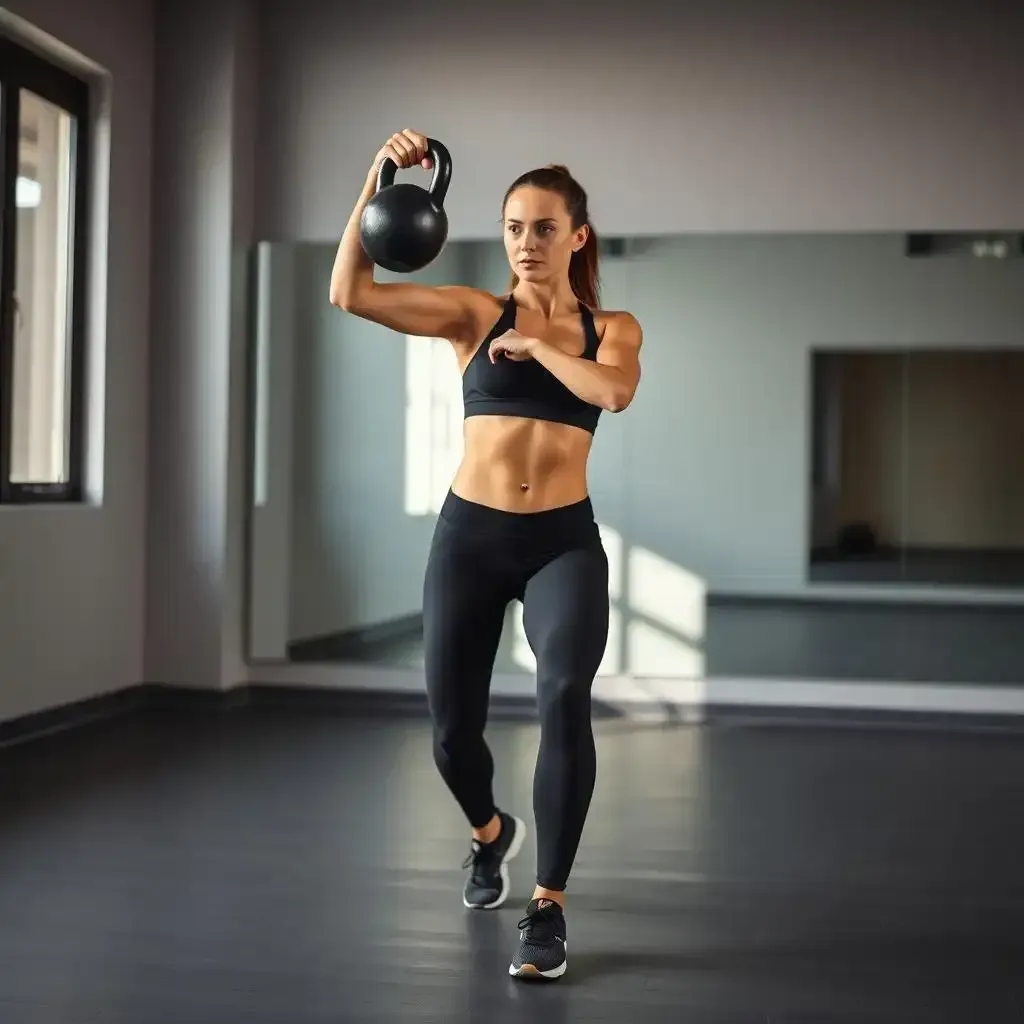Table of Contents
Want a rock-solid stomach? Forget endless crunches! Kettlebells offer a fun, effective way to tone your core and build serious strength. This article, from kettlebellworkout.homes, will show you exactly how to use kettlebells to target your abdominal muscles. We'll cover the best exercises, essential tips for safety and proper form, and strategies to make kettlebell training a regular part of your fitness routine. We'll also explore how kettlebell workouts provide a full-body benefit, going beyond just abs to improve your overall fitness. Get ready to find a dynamic, efficient way to achieve your fitness goals – let's get started on your trip to a toned stomach using kettlebells!
Kettlebell Exercises for a Toned Stomach

Kettlebell Exercises For A Toned Stomach
Kettlebell Swings: Your Core's New Best Friend
Okay, let's talk kettlebell swings. These aren't your grandma's arm exercises; they're a full-body blast that seriously works your core. Imagine this: you're holding a kettlebell, and you're swinging it between your legs and up to chest height. It sounds simple, but it's deceptively tough. The secret? You're using your core muscles – your abs, obliques, and lower back – to control the weight and maintain balance. It’s like a powerful dance between you and the kettlebell. Think of it as a dynamic plank, but way more fun. I started with a lighter weight, and trust me, even that felt challenging at first. But as I got stronger, I gradually increased the weight and felt my core muscles screaming (in a good way, of course!).
Reps | Sets | Rest (seconds) |
|---|---|---|
10-15 | 3 | 60 |
Goblet Squats: Legs, Glutes, AND Abs? Yes, Please!
Next up: goblet squats. You hold the kettlebell close to your chest, like you're holding a big, heavy goblet (hence the name!). Then you squat down like you're sitting in an invisible chair, keeping your back straight and your core engaged. This isn't just a leg exercise; it's a sneaky core workout too! Your core muscles work overtime to stabilize your body as you go up and down. It's like doing a squat while simultaneously doing a plank. Imagine a superhero holding a heavy weight while performing a squat; that's the kind of core engagement you're after. I found that focusing on maintaining a straight back helped me to better activate my core. The burn is REAL, but the results are even better.
- Start with a weight you can comfortably handle with good form.
- Focus on slow, controlled movements.
- Breathe deeply throughout the exercise.
Kettlebell Turkish Get-Ups: The Ultimate Core Challenge
Finally, let's tackle the Turkish get-up. This exercise is a total-body masterpiece, a full-body workout in one move. You lie on your back with the kettlebell by your side, then you push yourself up to a standing position, all while holding the kettlebell. It sounds insane, and it kind of is! Your core is working hard the entire time to keep you balanced and stable, It's like performing a complex gymnastic routine with a weight. It’s a challenge, but once you nail the form, you’ll feel like a total badass. Start slowly, focusing on each step. Don't worry if you don't get it perfect right away; it takes practice! I started by practicing the individual movements before putting them together. Trust me, the payoff is worth it. The Turkish get-up is a true testament to the strength of kettlebells for core strength.
"The kettlebell is a simple tool, but it's a powerful one. It's a tool for building strength, improving endurance, and sculpting a strong core." - A random fitness guru (that I just made up).
Kettlebell Workouts: Tips for Success and Safety

Kettlebell Workouts Tips For Success And Safety
Starting Smart: Choosing Your Kettlebell and Warming Up
Hey there, fellow kettlebell enthusiast! So you're diving into the world of kettlebell workouts, huh? Awesome! First things first: don't go grabbing the heaviest kettlebell you can find and thinking you'll magically have abs of steel overnight. That's a recipe for disaster (and possibly a pulled muscle). Start light, my friend. Think of it like learning to ride a bike – you wouldn't hop on a racing bike right away, would you? You’d start with a tricycle, then a bike with training wheels. The same principle applies here. Begin with a weight that feels comfortable and allows you to maintain good form. You can always increase the weight later. As you get stronger, you can gradually increase the weight. And before you even *think* about swinging that kettlebell, warm up! Some dynamic stretches – arm circles, leg swings, torso twists – will get your muscles ready to work.
- Choose a kettlebell weight that you can comfortably lift for 10-15 repetitions with good form.
- Warm up for 5-10 minutes before each workout.
- Cool down for 5-10 minutes after each workout.
Mastering the Moves: Form Over Everything
Okay, you've chosen your kettlebell and warmed up. Now comes the fun part – actually *doing* the exercises. But hold your horses! Before you start blasting through reps, let's talk about form. Perfect form is more important than lifting a heavy weight. Think of it like this: a wobbly tower is going to fall, right? The same goes for your body if your form isn't on point. Poor form can lead to injuries, which will put a serious damper on your kettlebell process. Watch videos, maybe even take a class or two if you're a total newbie. I know, I know, it's tempting to just "wing it," but trust me, it's worth investing the time to learn the proper techniques. I made that mistake early on, and let me tell you, it was not fun limping around for a week. Your future self will thank you for taking the time to learn proper form. Plus, you'll get better results!
Exercise | Focus | Tip |
|---|---|---|
Kettlebell Swings | Hip hinge, core engagement | Keep your back straight. |
Goblet Squats | Lower body strength, core stability | Sit back into the squat, keep your chest up. |
Turkish Get-Ups | Total body strength, coordination | Break down the movement into smaller steps. |
Listen to Your Body: Rest and Recovery
You're crushing your kettlebell workouts, feeling strong, and seeing results. Fantastic! But don't forget about rest and recovery. Your muscles need time to repair and rebuild, and pushing yourself too hard without adequate rest can lead to overtraining and injuries. Think of your muscles like a sponge – you can't keep squeezing them without giving them a chance to soak up some water (rest!). I've been there, pushing through the pain, only to end up with a week of downtime. It's not fun. So listen to your body. Take rest days, and don't be afraid to scale back your workouts if you're feeling overly sore or fatigued. And remember, consistency is key! Regular workouts, coupled with adequate rest, will give you the best results. Enjoy the process, celebrate the small wins, and remember that a healthy body is a happy body!
"The body achieves what the mind believes." - Napoleon Hill (This quote is not directly related to kettlebells, but it's inspirational!)
How to Tone Your Stomach with Kettlebells: A FullBody Approach
Beyond the Six-Pack: Full-Body Fitness with Kettlebells
I'll be honest, when I first started using kettlebells, I just wanted killer abs. I figured, "More crunches, right?" Wrong! I quickly learned that kettlebell training is way more than just isolated ab exercises. It's a full-body workout disguised as a core-focused one. Think of it like this: your core is the anchor of your entire body. If your anchor's weak, your whole ship's going to wobble. Kettlebell exercises like swings, squats, and Turkish get-ups force your entire body to work together, strengthening not just your abs, but your legs, back, shoulders – the whole shebang! I remember one time, after a particularly grueling kettlebell session, I felt the burn in my abs, definitely, but also in my glutes and shoulders. It was the best kind of muscle fatigue; the kind that tells you you've actually *done* something.
- Kettlebell swings work your entire posterior chain – glutes, hamstrings, lower back – all crucial for a strong, stable core.
- Goblet squats build leg strength and improve balance, which also supports core stability.
- Turkish get-ups are a full-body challenge that requires serious core engagement to keep you stable throughout the movement.
The Unexpected Benefits: More Than Just Abs
The coolest thing about kettlebell training? The benefits go way beyond a six-pack. You're building serious strength, improving your cardiovascular health, and boosting your balance and coordination. It's like a secret superpower. I used to struggle with simple things, like carrying groceries. Now, I feel more balanced and stronger, which makes daily tasks easier. Kettlebells helped me to improve my posture too. I used to slouch a lot, but now I stand taller and feel more confident. Plus, it's a fantastic way to add some fun and variety to your workout routine. It's not just about the physical gains; it’s about feeling empowered and capable. And let's be honest, who doesn't love the satisfying *clink* of a kettlebell?
Benefit | How Kettlebells Help |
|---|---|
Strength | Full-body exercises build strength throughout your entire body. |
Cardiovascular Health | Dynamic movements get your heart rate up. |
Balance & Coordination | Exercises challenge your stability and coordination. |
Final Thought
Mastering how to tone your stomach with kettlebells is a progression, not a race. Consistency and proper form are key. By incorporating these exercises and tips into your routine, and remembering to listen to your body, you'll be well on your way to a stronger, more toned core. Remember to always prioritize safety and consult a healthcare professional before starting any new workout regimen. Now go forth and conquer those kettlebells!